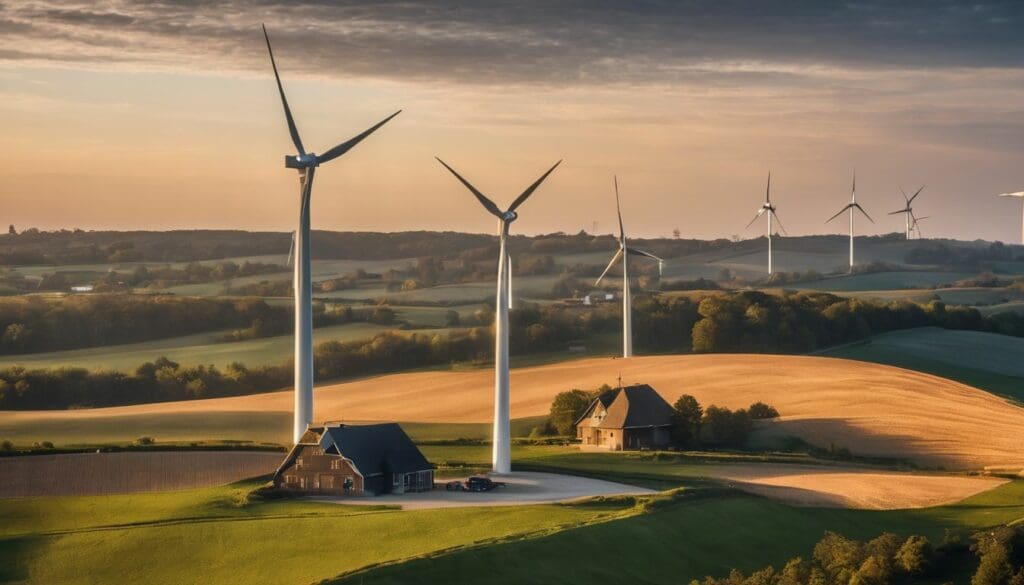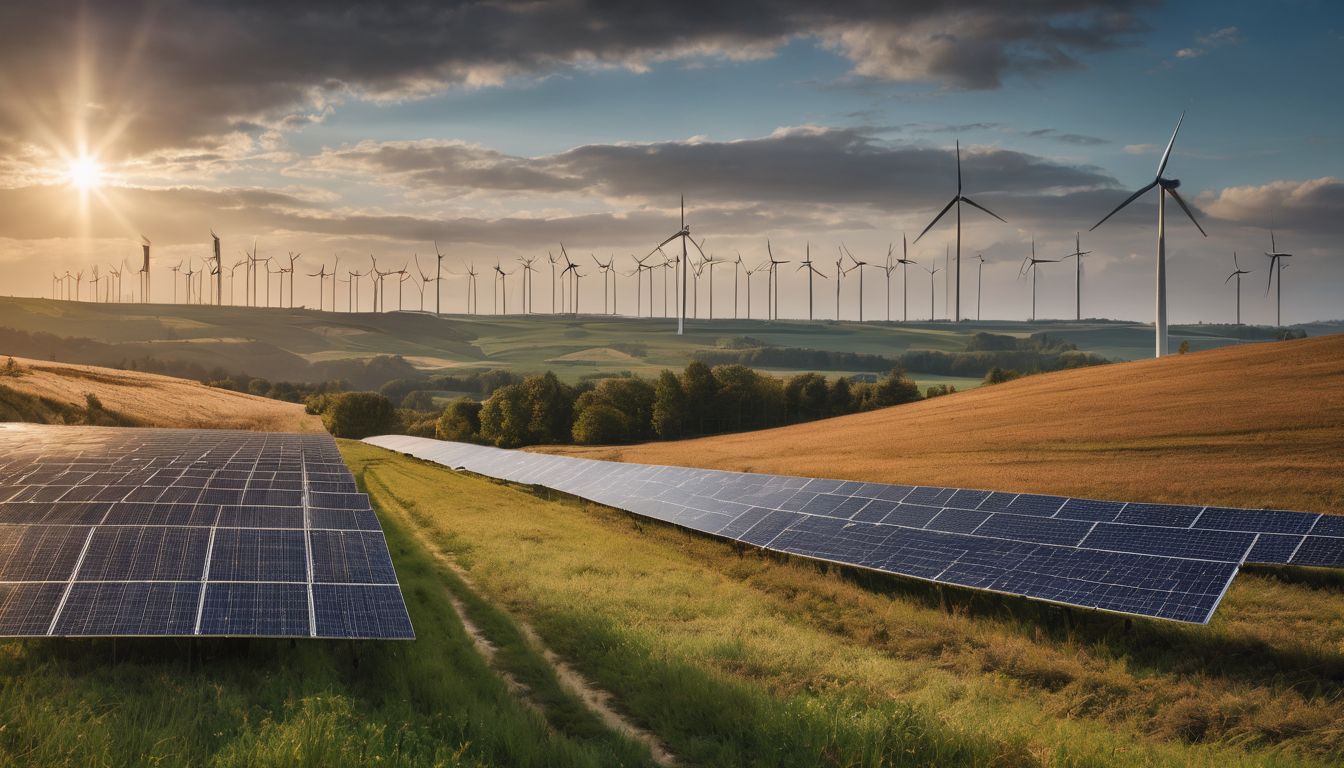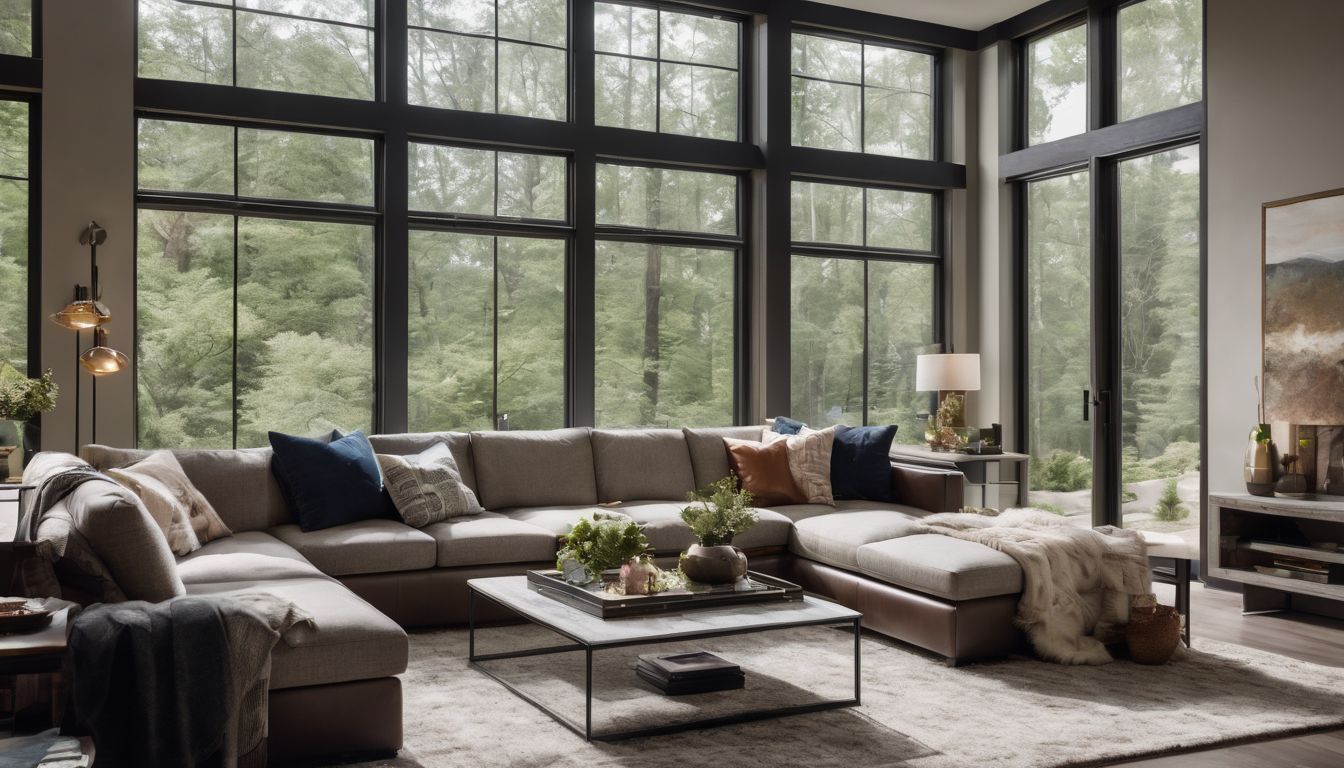Many homeowners wonder how to lower their energy bills and reduce their carbon footprint. Wind energy is capable of generating electricity for entire households without any polluting emissions.
This post will explore the benefits and drawbacks of harnessing the breeze at your back door, helping you decide if it’s right for your home. Discover the power of wind!
Key Takeaways
- Wind turbines use the kinetic energy from wind to produce clean, renewable electricity with no emissions, benefiting homeowners by lowering utility bills and reducing carbon footprints.
- While installation costs can be high, government incentives and the potential for long-term savings make wind energy a cost-effective solution for those seeking sustainable power sources.
- Homeowners must consider the intermittency of wind energy, as it relies on sufficient and consistent winds to generate power effectively; backup systems may be needed.
- Noise pollution from rotating blades and visual impact on landscapes are concerns; however, modern turbine designs are increasingly addressing these issues.
- The environmental benefits of wind energy include conservation of natural resources and minimal pollution; yet placement must be thoughtfully planned to avoid negative effects on local wildlife.
Understanding Wind Energy
Wind energy is a renewable source of power that harnesses the natural force of wind to generate electricity. This process involves using wind turbines, which convert the kinetic energy of the wind into mechanical power.
What is wind energy?
Wind energy harnesses the power of the wind to generate electricity. Tall turbines capture this natural resource and turn kinetic energy into a renewable, sustainable form of power that can light up homes and businesses.
Crucially, this process produces no greenhouse gas emissions, making it a clean alternative to fossil fuels.
As blades on the turbines spin with the force of the wind, an internal generator converts motion into electric current. This technology provides an inexhaustible energy source while also contributing to job growth in green industries.
Next, let’s delve deeper into how this dynamic system operates.
How does it work?
To generate electricity, wind energy harnesses the power of the wind by utilising turbines. These turbines are strategically placed to capture the kinetic energy present in the moving air.
As the blades of the turbine rotate, they drive a generator that produces electricity. The process involves converting mechanical energy into electrical power through a simple and efficient mechanism.
The system operates by transforming kinetic wind energy into mechanical power using rotor blades on a rotating hub, which spins a shaft inside a generator to produce electricity. This straightforward conversion facilitates clean and renewable energy production without relying on depletable resources or contributing to pollution.
Advantages of Wind Energy
Wind energy is a clean and renewable source of power that produces no greenhouse gas emissions. It also has low operating costs, making it a cost-effective option for homeowners looking to reduce their electricity bills.
Clean and renewable
Wind energy is an example of clean and renewable power. It harnesses the natural force of the wind to generate electricity, offering a sustainable alternative to traditional fossil fuels.
The process produces no emissions or pollution, making it an environmentally friendly option for homeowners looking to reduce their carbon footprint and support green living.
Utilising wind power allows for the generation of electricity without depleting finite resources, offering a cost-effective and sustainable solution in line with modern energy efficiency goals.
Low operating costs
Wind energy offers homeowners the advantage of low operating costs. Once a wind turbine is installed, the ongoing expenses are minimal, making it a cost-effective option for sustainable energy generation.
By harnessing the power of wind to produce electricity, homeowners can significantly reduce their utility bills and even earn extra income by selling excess power back to the grid.
The economic benefits of wind energy further contribute to its appeal as an environmentally friendly choice for homeowners. With lower operating costs compared to traditional energy sources, wind power aligns with off-grid living and supports sustainable environmental practices.
Space-efficient
Wind energy is space-efficient, making it ideal for homeowners with limited land. Unlike traditional power plants, wind turbines can be installed on properties without taking up much space.
This means that even in areas where land is at a premium, homeowners can still take advantage of this clean and renewable energy source to power their homes. Additionally, because the footprint of wind turbines is minimal compared to other forms of electricity generation, they are an attractive option for those looking to live off-grid or reduce their environmental impact.
For environmentally conscious individuals interested in sustainable living or cutting down on utility costs, wind energy offers a practical solution that doesn’t require vast amounts of land but still provides a steady source of clean electricity.
Economic benefits
With its space-efficient design, wind energy brings significant economic benefits to homeowners. By harnessing the power of the wind, individuals can reduce their reliance on traditional electricity sources, leading to lower utility bills and long-term cost savings.
Additionally, many countries offer financial incentives and tax credits for those who invest in renewable energy sources like wind power. These incentives can further enhance the economic advantages of adopting wind energy for homeowners looking to live more sustainably while also saving money in the process.
Disadvantages of Wind Energy
Intermittency, noise and visual pollution, impact on wildlife, and location limitations are all factors to consider when thinking about installing a wind energy system for your home.
Read more to find out how these disadvantages can be addressed and if wind energy is the right choice for you.
https://www.youtube.com/watch?v=kmSuKa2w36Q
Intermittency
Wind energy’s intermittency is a key drawback. It means that wind turbines produce power only when the wind blows, so it isn’t a consistent energy source. This can pose challenges for homeowners who rely solely on wind energy, as they may need alternative power sources during periods of low or no wind.
For homeowners considering wind energy, understanding its intermittent nature and planning for backup power sources is essential in ensuring continuous access to electricity. Adequate preparation can help mitigate the impact of intermittency on home energy systems.
Moving on to “Noise and Visual Pollution” – let’s explore how these factors might affect your decision to adopt wind energy at home.
Noise and visual pollution
Wind turbines can generate noise pollution as the blades rotate and the mechanical components operate. This can be a concern in residential areas where homeowners may find it intrusive.
Visual pollution is also a consideration, with some people finding wind turbines unattractive in rural landscapes. Both factors should be carefully considered when planning wind energy installations to minimise impact on local communities and environment.
When locating wind turbines, it’s important to assess potential noise and visual impacts on nearby residents and wildlife. Design considerations such as rotor blade shape, orientation of the turbine, and distance from homes can help mitigate these concerns.
Impact on wildlife
Wind energy has an impact on wildlife, primarily due to the potential harm posed by rotating turbine blades. Birds and bats are at risk of collision with the blades, impacting their populations in certain areas.
Additionally, noise from wind turbines can disrupt natural habitats for various wildlife species, affecting their breeding and feeding patterns.
The installation and operation of wind farms can lead to habitat fragmentation and disturbance for local wildlife. Despite these concerns, measures such as proper siting of wind farms and ongoing research into wildlife interactions seek to minimise these impacts on biodiversity.
Location limitations
Wind energy may not be suitable for all locations due to specific requirements. The availability of consistent wind is crucial, so areas with low or inconsistent winds may not be ideal for wind energy generation.
Additionally, local zoning regulations and proximity to residential areas can limit where wind turbines can be installed.
Understanding the location limitations when considering wind energy is essential. It requires a detailed assessment of wind patterns and local regulations to determine if your location is suitable for harnessing this renewable resource effectively.
Addressing Common Questions
Concerned about noise levels and the dependence on wind for consistent energy? Wondering about the cost-effectiveness and environmental impact of wind energy for homeowners? Read on to find out more.
Noise levels
Wind turbines generate some level of noise as the blades rotate, which can be a concern for those living in close proximity. However, advancements in wind turbine technology have significantly reduced the noise levels produced.
Modern designs and engineering techniques have addressed this issue, making wind energy a much quieter and more viable option for homeowners looking to embrace clean and renewable energy solutions.
When considering wind energy options for your home, it’s important to research and choose from the latest turbine models that are specifically designed to minimise noise disturbance while maximising energy efficiency.
Dependence on wind
Transitioning from noise levels, it’s important to consider the dependence on wind when it comes to wind energy. Since wind is the driving force behind generating electricity from turbines, the amount of power produced is directly related to the speed and consistency of the wind.
Homeowners considering wind energy should evaluate their location for adequate and consistent wind resources – this will greatly influence the effectiveness of harnessing wind power.
Understanding local weather patterns and consulting with renewable energy experts can help homeowners determine if their area has sufficient winds to support a residential turbine system.
Cost-effectiveness
When considering wind energy, it’s important to assess its cost-effectiveness. While the initial investment for a home wind turbine may seem significant, the long-term savings on electricity bills can make it a financially sound choice over time.
Additionally, government incentives and rebates are available in many areas to help offset installation costs, making wind energy even more affordable for homeowners looking to go green and reduce their carbon footprint.
Choosing wind energy for your home is a cost-effective way to harness clean and renewable power while reducing your reliance on traditional grid electricity. The economic benefits combined with the environmental advantages make investing in wind energy an attractive option for environmentally conscious individuals seeking sustainable living solutions.
Environmental impact
Considering wind energy’s environmental impact is crucial for environmentally conscious homeowners. Generating electricity from wind produces no air or water pollution, making it a clean and sustainable option for reducing carbon emissions.
Additionally, harnessing wind power conserves natural resources and minimises the reliance on non-renewable fuels, aligning with green living principles. The minimal environmental footprint of wind turbines also complements off-grid living solutions, making it an attractive choice for those aiming to reduce their ecological impact.
Conclusion
In conclusion, wind energy offers homeowners a clean and renewable option for powering their homes. The low operating costs and space efficiency make it an appealing choice for environmentally conscious individuals.
However, it’s important to consider the intermittency, noise, visual pollution, and impact on wildlife when evaluating its suitability for specific locations. Overall, wind energy presents both advantages and disadvantages that homeowners should carefully weigh before making a decision.
FAQs
1. What are the benefits of wind energy for homeowners?
Wind energy offers clean and green energy, making it a cost-effective choice for homeowners interested in off-grid living or reducing their carbon footprint.
2. Is wind energy a space-efficient choice for homes?
Yes, modern wind turbines designed for residential use tend to have a small footprint, allowing homeowners to generate power without sacrificing much space.
3. Can I completely rely on wind energy to power my home?
While wind energy can significantly contribute to your home’s power supply, its consistency depends on your location’s wind patterns; some may still need connection to the grid or alternative energy sources as backup.
4. Are there any downsides to using wind energy at home?
One potential con is that initial installation costs can be high and it might not be suitable for locations with minimal or unpredictable winds; careful consideration is needed before investing.





